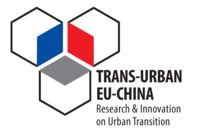
TRANS-URBAN-EU-CHINA
Transition towards urban sustainability through socially integrative cities in the EU and in China
Monitoring & Evaluation
1. Purpose(s)
The aim of monitoring and evaluation is to consistently track and determine the level and the degree of success achieved in the implementation of agreed strategic goals, actions and measures. A Successful monitoring and evaluation process enables involved parties to make suitable and adequate adjustments, where necessary. Specific indicators are required to ensure effective results through a clear and transparent evaluation process.
Key Words: monitoring; evaluation; strategic goals; indicators; process; tracking
2. Relevance and Impact
Regular and real time monitoring and evaluation, embedded in the strategic and/or project plan from the very start can lead to a more effective strategic and operational steering of the implementation process and will potentially deliver better outcomes.
The tool was tested in an online workshop with Chinese experts. In China, the aim of the used evaluation and monitoring tool is to evaluate the quality of urban development projects by applying an indicator system covering various dimensions of quality of life. This method is mainly applied at the national or provincial level to facilitate the horizontal comparison of the development level of various cities. This method mostly focuses on the construction of information infrastructure and public service systems. One of the conclusions was that monitoring and evaluation is mostly already a standard within projects, but to measure the impacts it is equally important. This can be achieved through defined clear targets, understanding the framework and how the figures are created. Another derived conclusion was that a political will is required for target monitoring. The responsible persons need specific competences, to make the person visible, and receive the right to request information and data form other people, otherwise monitoring will cause problems and extra work for the responsible persons. Monitoring and evaluation will help to close the planning implementation gap, but it needs to be combined with other tools, e.g. citizen participation tools and/or agile project management. Another input was to go one step further and create indicators to measure socially integrative cities.
3. Strenghts
In line with clearly defined goals, a well-structured and guided monitoring and evaluation strategy helps to maintain informed decision-making processes, align and adjust different actions and measures set goals.
4. Weaknesses
Ambiguous and imprecise goal-setting in the strategic planning documents may lead to a range of difficulties in the monitoring process, such as complications in the definition of indicators and related data gathering and clarity in the distribution of roles and reporting responsibilities in the monitoring process.
5. Good practice examples
Stockholm (map): Royal Seaport - Frequent & collaborative monitoring
The monitoring and evaluation process has been outlined in the strategic plan through definition of monitoring metrics and specification of related responsibilities and roles. The instrument of the civil contracting between the City of Stockholm and the developers (who are an inclusive part of interactive working groups) are the monitoring and reporting loops, which are embedded in the process of implementation. Such ‘built in’ frequent reporting practice creates a direct feedback on the achievements of the sustainability requirements in the implementation activities. In addition, all working group participants are requested to share experiences within their administration. Furthermore, a continuous exchange of information between different City of Stockholm projects is a common practice in Stockholm. Such different formats of experience exchange and progress tracking enable monitoring and evaluation processes to become a central part of the development process.
Annual Stockholm Development Administration reports present the outcomes and the key contributions of the different projects to the overall city planning and implementation framework and strategy. A wide distribution and dissemination of the sustainability report and monitoring reports enables the public as well as different external stakeholders to obtain access to this information and to draw information from the lessons learned.
6. References
7. Author(s) of the article
Christoph Brodnik
